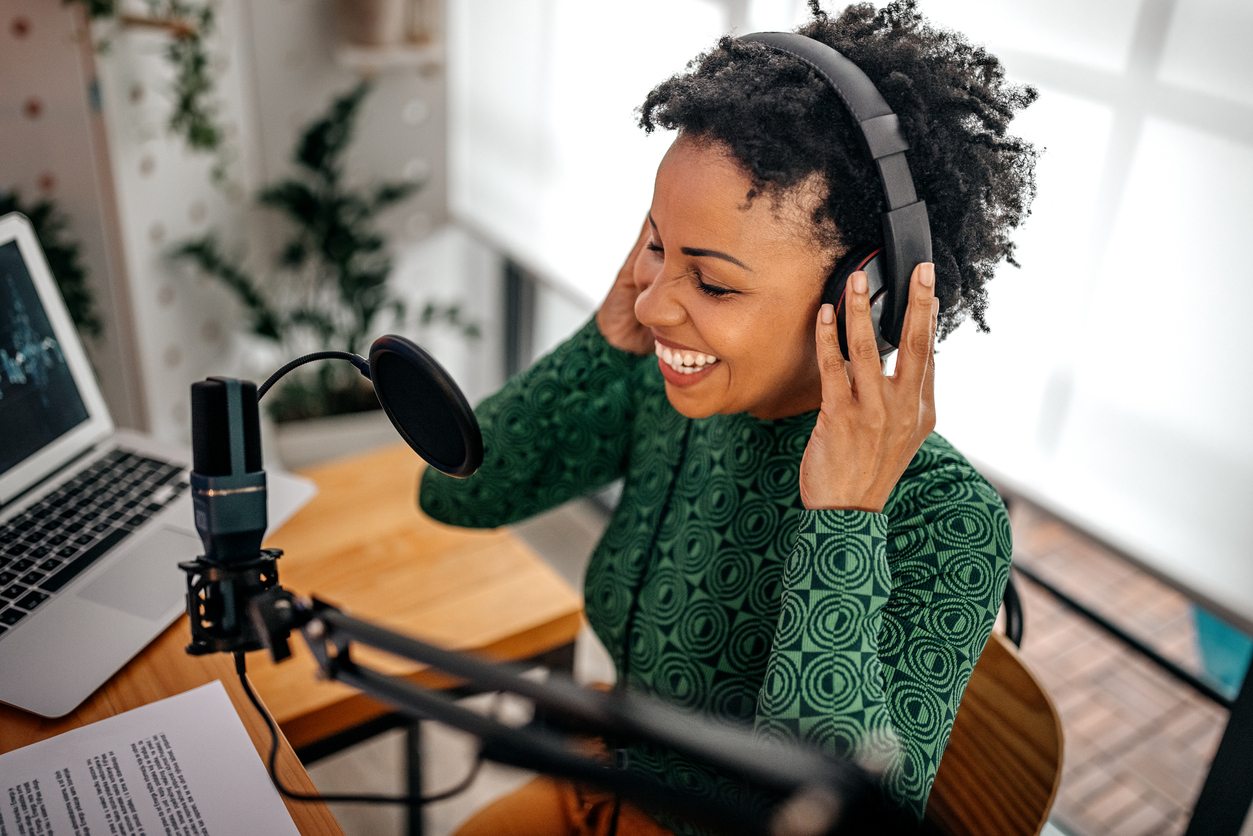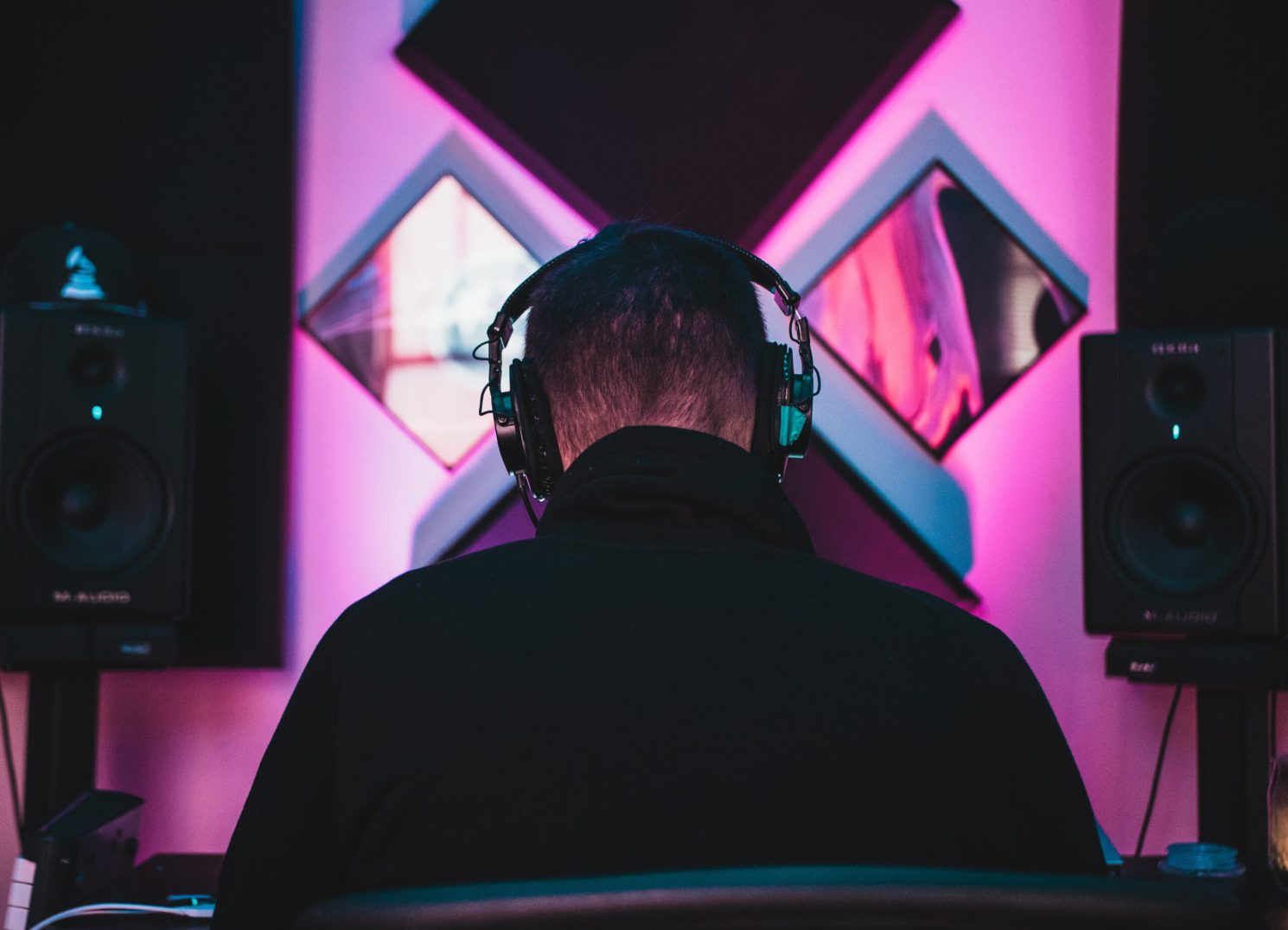What is audio branding?
Audio branding, also known as sonic branding is the use of sound to define, reinforce and strengthen a company’s identity. If you can hear it, it can play a part in getting your business noticed, and companies may deploy one, all, or a combination of these elements across various marketing channels to help keep their business front-of-mind with their clients.
Whenever a company uses music or spoken word as part of a customer experience, they’re practising audio branding – whether this be online, over the phone, in a podcast, at an event, in a store, or within any other auditory channel. These assets and marketing materials can be deployed on various platforms to illicit that all-important emotional response from their customers.

Why is audio branding so important?
Audio branding is a powerful marketing tool that can help your business stand out. It can create a memorable experience for your customers and make it easier for them to find and buy what you have to offer. By creating an audio identity for your business, you can set yourself apart from the competition while increasing brand awareness and loyalty.

Audio branding for business
Used effectively, audio marketing inspires emotion, drives purchase intent and tells the story of the brand – making it a vital consideration in a company’s identity and marketing activity.
Why sound is part of an incredible brand/product experience
Audio encompasses many aspects, but it’s music that most often springs to mind – and forges the strongest connection in our brain. The link between music and experiences is neurological, meaning there’s a scientific reason why hearing the chorus of a certain song instantly triggers memories of a certain place or time, and all the emotions that came with it. This is a powerful phenomenon, and when brands capitalise on this, it becomes powerfully lucrative.
Why you should be using audio branding
We’re living in the age of audio. Whether it’s a podcast on the morning commute, a powerful playlist to get us pumped up for the gym, or a query answered by Alexa as we cook up our evening meal, we’re consuming, adopting and interacting with sound more than ever before – meaning there’s never been a better time for businesses to make themselves heard.

Always listening
Audio streaming is nothing new, but it’s reached its most prolific peak to date. Spotify currently has more than 286 million monthly active users – 130 million of which pay for a premium account – and has seen consistent year-on-year growth since 2015.
More people than ever are creating the soundtrack to their lives, and using music to influence their moods – wherever they are, and whatever they’re doing. With 60% of people’s streaming done on mobile, headphones are no longer an accessory, but an essential. And these big figures add up to lucrative opportunities:
0%
0%
0m
0m
Look who’s talking
Consumers aren’t just listening – they’re using their voices too. Much like streaming, the adoption of voice activation technology is firmly on the up, which is changing the way we search.
We’re all getting used to speaking to the technology around us, especially in our homes. And as consumers converse with their devices, it means brands can start to have direct conversations with their customers too – exchanges that lead directly to sales.

So what does audio branding look like in action?
Sonic logos are the quickest way to get a potential customer listening to what you have to say, as they memorably convey company identity in just a few short seconds. And with ever-increasing opportunities to deploy this feature, there’s an even greater chance of market dominance across multiple, receptive channels.
Some of the memorable sonic logos are Netflix’s ‘ta-dum’ or McDonald’s “bada ba ba ba” using very few notes and keeping it short and simple. Here are some examples you might recognise – even without realising you recognise them.
And in 2021, Apple commissioned an artist to create a song, ‘Start up’, using only start-up noises from across its 45-year history. The full 1:42 clip shows the process of composing the song, which is not dissimilar to the process we follow when composing tracks for clients.
As a piece of marketing, this isn’t particularly likely to convert anyone to the Apple brand – but it might make existing users even firmer fans, and therefore more likely to stick with Apple technology in future.
Sound waves have incredible power, which German beer brand Becks used to their advantage in 2021. It faced a challenge: how to get consumers in Brazil used to the flavour of its beer, which is more bitter than local tastes are accustomed to. The answer, unbelievably, lies in low-frequency sound waves.
These alter the perception of bitter flavours, so Becks filmed an experiment with users drinking a generic beer – changing the frequency repeatedly, and altering the flavour from one sip to the next.
Our sense of hearing can be amplified if one of our other senses is limited in some way, so using audio effectively can make a huge difference for consumers with sight loss. Broadcast sports relies heavily on visuals, with commentators often unable to keep up with rapid-fire action: a problem for tennis in particular.
In 2021, Tennis Australia – responsible for organising and promoting tennis tournaments across the country – used the data it collected through ball-tracking technology, which it already used to judge line calls, in a new way: to help visually-impaired viewers enjoy the game through ‘Action Audio’.
While these examples may be some of the most impressive, they’re not the only ways companies can use sound to affirm their identity.
Whenever a company uses music or spoken word as part of a customer experience, they’re practicing audio branding – whether this be online, over the phone, in a podcast, at an event, in a store, or within any other auditory channel.
Benefits of Audio Branding
Audio ads are memorable and motivational – they drive 24% higher recall than display ads, and are twice as likely to life purchase intent.
Spotify for Brands report, 2020
Why you should be using audio branding
Companies have long lived in a predominantly visual world. Branding considerations or spend has historically been devoted to what we can see – logos, colours, fonts, print and billboard adverts, websites and all those other elements that appeal to the eye.
But this isn’t enough to make a business stand out. Consumers are bombarded by images, so much so that the visual messages we scroll through, watch on our screens or see in the cities around us barely register. It takes something else to cut through this noise – and this is where audio comes in.
Our connection with sound begins while we’re still in the womb, and it remains a core sensory and semantic cue throughout our entire lives. The things we hear cement themselves in our brain much faster and more firmly than those delivered through the visual counterpart, so it’s no surprise that audio is proven to enhance customer receptivity.
Your audience doesn’t have to be engaging in a specific activity
Coupled with this remarkable responsiveness is audio’s accessibility. Unlike video or other visual media, we don’t have to stop to consume it – which is why the majority of audio consumption takes place while we’re engaged in other tasks. Sound reaches us where images cannot, weaving its way around our daily activities to become an essential part of our lives.
Elements of an audio brand
1.
Scriptwriting
Every brand has a message to convey, and this is most often delivered through the screen or page. But when these words are designed to be heard, certain considerations have to be made. Unlike a reader, a listener doesn’t have print in front of them to process in their own time – so copy must be created with brevity and conciseness for maximum comprehension. How the words sound when spoken out loud is also an important element, and many of the most famous straplines owe their success to their auditory qualities. Just think ‘Snap, Crackle and Pop’; ‘Maybe she’s born with it, maybe it’s Maybelline’ or Jaguar’s ‘Grace, Space, Pace.’
Thanks to their onomatopoeia, alliteration and rhyme, they all roll straight off the tongue and into the ear – which is a significant part of what makes them so memorable. Nuances like these require expertise in writing for audio, which is why businesses should entrust this task to a specialist Copywriter.

2.
Voice artistry
Male or female… old or young… authoritative or conversational… the qualities of a company’s personality are inherent in the way they speak to their consumers. Therefore, it’s essential that the word of a brand is spoken by a voice artist who isn’t just professional, but delivers with the tone and style that’s wholly representative of their identity.
As the previous statistics show, the use of voice activation technology is at an all-time high – which means there’s never been a more important time for businesses to invest in voice as a brand asset. Developments in this area open up the choice of assistant from Alexa, Siri or Hey Google to something altogether more representative of the business. When there’s a chance to have a direct conversation with the consumer, it’s vital to know which voice will do the talking.

3.
Exclusive music
Music’s power over our memories and emotions make it a no-brainer for branding purposes – and when these are positive, it’s a brilliant reflection on the business. But what if it’s not? For every song that stirs memories of first loves or ultimate highs, there’s an equivalent for a bad break-up or a low you’d rather forget, and this is something a company has no control over. With one play of the ‘wrong’ track, a business is forever negatively interlinked in the mind of the consumer, which is potentially damaging to the future relationship.
Far more effective is to develop a track exclusive to the business. Commercial composers have the unique ability to distil a company’s identity into a piece of music, crafting every note, beat and melody to capture what makes them unique. Always fresh to the ear, this composition carries no preconceptions – making it a blank canvas for a company to build strong associations. With every play, it’ll become more synonymous with a first-class product or service, ultimately creating a powerfully positive sonic trigger.

What are the key audio touchpoints for a consumer?

Online

On TV, radio and streaming platforms

On the telephone

In person

On voice-activated devices

At work
How to get started with audio branding
Get in touch today for a free consultation, we’ll help you to identify your goals and then we’ll help you choose the right sounds and music for your brand. Be sure to select something that reflects your company’s values and personality. Once we have the audio elements in place, we can to create a plan for using them and implement it.

Why you should partner with PHMG
We’re the world’s leading audio branding experts. With over 20 years’ experience and 32,000 clients, we have a wealth of experience in building out audio marketing strategies that deliver measurable return on investment.
Our audio productions resonate with audiences, helping to generate additional revenue while saving you money. We’ve delivered audio to some of the largest and most well-known brands in the world — you’ll have heard what we do without even realizing it.



